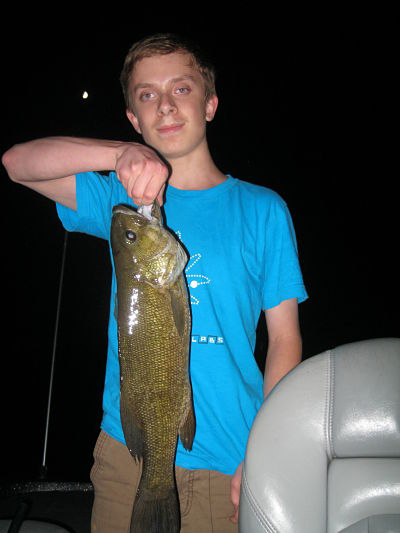
I’ve always loved night fishing for bass, and I’ve been doing it a long time. As a fishing guide and tournament angler, I don’t often get to pick the times I go fishing, but in the summer I’m almost always going to choose the night bite.
There are several reasons I like bass fishing after dark in the summer, but the biggest are that there’s less boat traffic and better water conditions. When kids are out of school and parents are on vacation, your favorite lake or reservoir likely turns into a watery playground. I know that’s true on the waters of Kentucky and Tennessee where I do most of my fishing.
With the reduction in boating pressure that comes after dark, I can fish areas that I couldn’t even get to during the day because of all the water skiers, jet skiers, tubers and pleasure boaters.
If you’ve ever tried to methodically work a bait in 25 feet of water while a skier passed within 10 yards of your bass boat, you know what I’m talking about. Rather than fight them for the spot, I decided a long time ago to let them have it during the day and fish it at night. The fishing’s better after dark anyway.
At the end of this series, I want you to be ready to tackle bass after dark, and if you’re already a night fisherman, I want you to improve your skills through what you read here. We’ll start with preparation.
You know what they say: If you fail to plan, you plan to fail.
Ahead of the curve
For this summer’s fishing, it’s already too late to do the first step in planning that I’m going to recommend, but I want to cover it so you’ll be ready for next summer.
My preparation for summertime bass fishing actually begins in the winter, when water levels are drawn down on many reservoirs around the country. That’s the ideal time to take a break from watching football and plant some cover on your favorite lake.
If you’ve never planted brush before, it’s not hard. All you need are some hardwood trees that you can either cut down or retrieve from trash piles, some rocks or cinder blocks and some big zip ties. A lot of anglers like to use discarded Christmas trees. I realize they’re easy to find and collect, but they’re not very good as bass cover. Since the limbs are so close together, bass can’t get into the middle of the brush easily. A better choice is something like a dogwood or other hardwood with plenty of limbs that aren’t so dense.
Wooden pallets are also great for this, and you can sometimes get old ones from warehouses that would otherwise throw them away.
Building a bass home
Once you’ve got your limbs or pallets, it’s time to start building. Using zip ties, wire or twine, tie the brush together until you have a substantial piece of cover. I like to make my brushpiles about half the size of a bass boat. Anything bigger is too hard to handle; anything smaller can be difficult to locate after you sink it and will deteriorate more quickly underwater.

If you’re working with pallets, try tying them together in a pyramid shape. That way, no matter how they land or shift on the bottom, they’re always standing up and creating a sizeable piece of cover.
Don’t weight your brushpiles until you have them out on the water and are ready to sink them. Weighting them sooner than that just makes them harder to handle. I like using big rocks that I find along the shoreline, but cinder blocks or bricks are easier to work with and attach, if you can find some.
Location, location, location
I haven’t even mentioned the most important part of planting cover in your favorite bass lake. Here it is: You need to put it in an area that’s already productive. It’s not going to miraculously transform a bad area and put bass where none were before. All the cover can do is concentrate bass that are already in the area.
When the water is drawn down in the winter, it’s easier to plant your cover, but you need to be aware of the depth at the time you plant and what the depths will be months later when you plan to fish the cover. Ultimately, you want your cover to be 18 to 25 feet deep in summer. If your lake has been drawn down by 10 feet, that means it should be eight to 15 feet deep when you plant it. Your goal is to put it right around the thermocline or just above it. You can find the thermocline now and keep it in mind when you’re planting cover this winter.
If your lake level is drawn down more than 25 feet or so in the winter, wait until it comes up some before planting your cover. If everyone sees it, everyone will fish it, and you’ll have created a community hole rather than a personal hotspot.
Remember, planting cover in public water may be regulated by the lake authority, so check to see if you need a permit.
In Part II, I’ll cover the equipment you’ll want to have in your boat for a safe and successful night fishing trip. It’s not a long list, but it’s an important one.
Editor’s Note: You can contact Bobby Gentry at 270-427-0419 or through his website.




